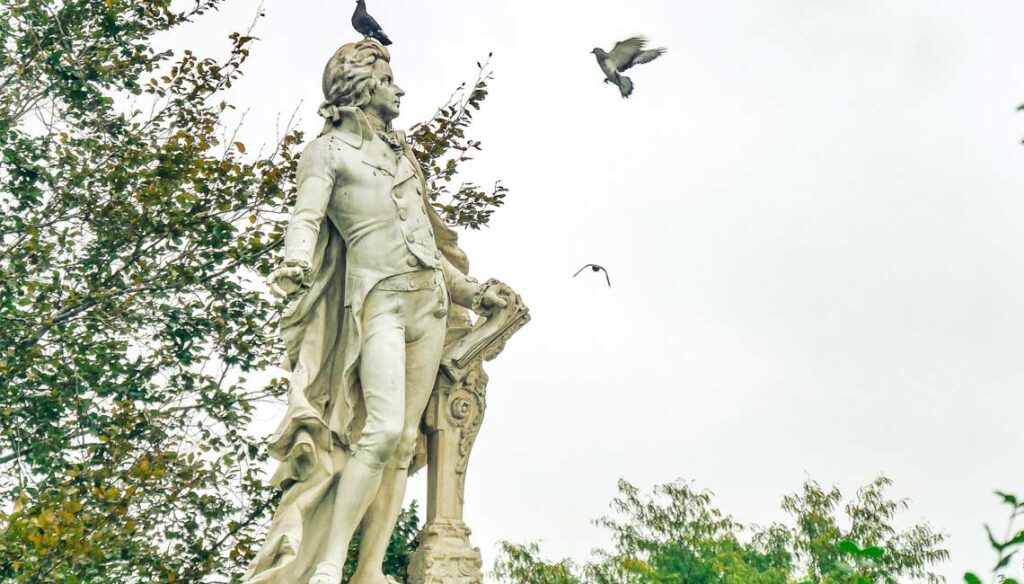
What unusual dread seizes my faculties!
Don Giovanni
From whence arise these whirlwinds of horrid fire?
Who lacerates my soul?
Who stirs up my entrails?
What torture woe is me, what frenzy!
What hell, what terror!
In the last years of his life, the musical prodigy Wolfgang Amadeus Mozart decided to start a freelance life in Vienna. He gave up working exclusively for the Salzburg court in order to attend to commissioned works and sell those creations that really pleased his genius. However, his finances dwindle, he lives from day to day and fails to become a rich musician despite his immense talent.
It is at this time that he marries, forms his own family, and composes his opera Don Giovanni (KV 527), considered the cornerstone of this musical genre. Mozart decides to make his own version of a recurring character in literature and art. The work in Italian premiered in 1787 and he calls it drama giocoso, that is, a mixture of action, comedy, and drama with “supernatural elements”, as the author himself defined it.
This opera also shows the personal interests of the Austrian musician, who perhaps saw himself identified with that character who flaunts his freedom and defies all human and divine laws. He was also a bit like him: arrogant and libertine, although Mozart was not a murderer, nor an abuser like Don Giovanni. Thoughts of death, in all its forms, haunted his mind constantly, and he had a great conviction to live his present with joy.
It was a time of high mortality, due to various causes unknown to medical science. Mozart had lost several of his siblings when they were still children; moreover, after marrying his wife Constanze Weber, he lost four young children. He resented the death of his father, who was his teacher, friend, and the most solid companion for the development of the great artist he was. His mother also died of a long and painful illness.
Therefore, it is not strange that the last scene of Act II of the opera ends with Don Giovanni’s presence in the cemetery, where he had fled from his persecutors, and revives in front of him the tomb statue of the Commendatore, whom he had murdered moments before after having abused his daughter. Death is represented in that character seeks revenge, Don Giovanni mocks the dead man and, without fear, invites him to a feast in his palace.
To the disbelief of the partygoers, the revived statue of the deceased appears, demanding Don Giovanni’s repentance, while he refuses to stop being him and renounce his hedonism; he is then dragged by the dead man to hell. In a great theatrical display, the orchestra accompanies this entire act in D Major, and the moral of the opera is recited: “Such is the end of those who do evil: the death of the sinner always reflects his life”.
This story coincided with the way of life of its author who, if he had any profit, squandered it on pleasures, trips, wines, new instruments, expensive schools for his children, and even a billiard table, leaving no option for savings.
With large debts on his shoulders, Mozart applies to become an assistant chapel master at St. Stephen’s Cathedral. He realizes that the titular maestro is very ill and will soon die, so he thinks he will replace him in a short time. By chance, and as if it were an opera, the old chapel master is saved and Mozart falls seriously ill.
His health had deteriorated due to a life of unstoppable work that began at the age of five. He had also suffered from rheumatism since childhood, which caused kidney infections that often confined him, and he came to believe that he was being poisoned by envious colleagues. Mozart defied death as Don Giovanni and continued to work tirelessly on another opera and various musical pieces.
It is said that, in the summer of 1791, a stranger came to Mozart’s house to commission him to write a requiem, that is, a composition in D Minor based on the Catholic liturgical acts celebrated at a person’s funeral. This turned out to be for the deceased wife of a frustrated count and musician, who wanted to claim his authorship, and the genius composer was not in a position to refuse any job offer. Suggesting that the Requiem (K 626) would be for his own burial, he assumed that it would be for his own funeral.
Mozart died on December 5, 1791, at the age of 35, and the work remained unfinished. Sometime later, his disciple Franz Xaver Sússmayr fulfilled his posthumous wishes and had it finished, based on his indications, and registered it in Mozart’s name. It premiered in January 1793.
It was Wolfgang Amadeus Mozart who established the rule of writing requiem music in the solemn D Minor. He also stated that, no matter how afflicted a person may be, music should always be pleasing to his or her ears.
The story of the death of this genius is related to his fondness for the supernatural because of his deep spirituality, which prevails in his work. It is said that those who are about to depart sense it. With the grace of his talent, he expressed himself openly about death through his music.
In Del Pueblo Funeral Home we know that in Mozart’s time medical advances were precarious and there was a certain intuition of foresight before the inevitable. His extraordinary musical legacy makes us enjoy, it while at the same time inviting us to reflect. Thus, we remind you that we make the most difficult moments easy.
